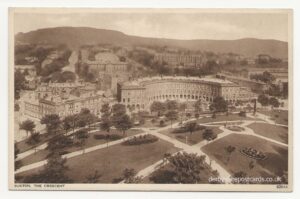BUXTON
from Wikipedia
Buxton is a spa town in Derbyshire, England. It has the highest elevation – about 960 feet (290 m) above sea level – of any market town in England. Close to the county boundary with Cheshire to the west and Staffordshire to the south, Buxton is described as “the gateway to the Peak District National Park”. A municipal borough until 1974, Buxton was then merged with other localities lying primarily to the north, including Glossop, to form the local government district and borough of High Peak within the county of Derbyshire. Economically, Buxton is within the sphere of influence of Greater Manchester. The population of the town was 22,115 at the 2011 Census.
Buxton stables and dome
Above the crescent, on the west side, the 6th Duke of Devonshire built a fine circular set of stables, which he gave to charity in 1859 to be converted into the Devonshire Royal Hospital. The architect, Henry Curry, covered the circular exercise area in the centre of the stables with a huge iron-framed dome covered in slate.
Until recently this was the largest unsupported dome in the world.The hospital closed about 2000 and the building was converted by the University of Derby, as the centrepiece of their Buxton campus.
Buxton Crescent
Buxton Crescent was opened in 1784. Built by John Carr for the Fifth Duke of Devonshire with a view to developing the ancient spa it cost £120,000.
Traditionally this is said to have been paid for from the profits of his copper mines at Ecton in the Manifold Valley but this is given little credence at Chatsworth. Built of local stone along with the impressive domed stables.
Henry Curry, covered the circular exercise area in the centre of the stables with a huge iron-framed dome covered in slate. Until recently this was the largest unsupported dome in the world.
The stables were later to become the Devonshire Hospital which closed in 2000 and then converted by the University of Derby, as the centrepiece of their Buxton campus.
The position of the Crescent at the foot of the Slopes is believed to be due to a stubborn landowner who asked too much for the preferred imposing site on the hill top.
St.Anne’s Well, one of the seven wonders of the Peak, faces the Crescent and St. Anne’s Chape stood here until it was closed by Henry VIII.
Old Buxton Market Place stands on the hill top, and claims to be the highest market place above sea level in England. It still keeps the stump of its old cross
St Anne’s Well
The spring at St Ann’s well was probably a place of pilgrimage as early as the Middle Ages, but certainly by Tudor times it was fairly well established as a spa and in Elizabeth I’s time it was visited for this purpose by The Earl of Leicester, Lord Burghley and no less than Mary Queen of Scots, who was being held captive by the Earl of Shrewsbury and his wife Bess of Hardwick at nearby Chatsworth.
The Old Hall Hotel dates back to 1573 when the captive Mary Queen of Scots stayed at the hotel.
from Derbyshire Heritage
Solomon’s Temple stands high above Buxton at Grin Low and it is said to have been built to provide work for the unemployed.
It was built in 1895 replacing a simple structure which had become a ruined heap of stones.
The original Grinlow Tower had been erected earlier in the century by the Duke of Devonshire but at the time of its reconstruction the surrounding land was occupied by one Solomon Mycock, hence its name. Hardly a Temple at 20 feet high it was restored in 1987.
Solomon’s Temple was built on the site of an ancient burial mound, a Bronze Age barrow, and during the tower’s construction an archaeological dig revealed several Bronze Age skeletons from the ’Beaker’ period, along with later Roman items.
This is an interesting Photochrom Lettercard from Buxton























